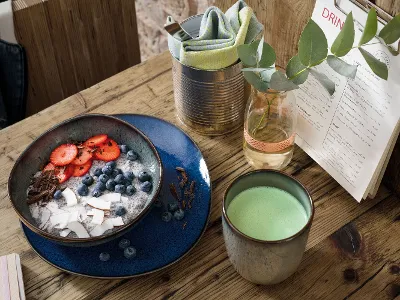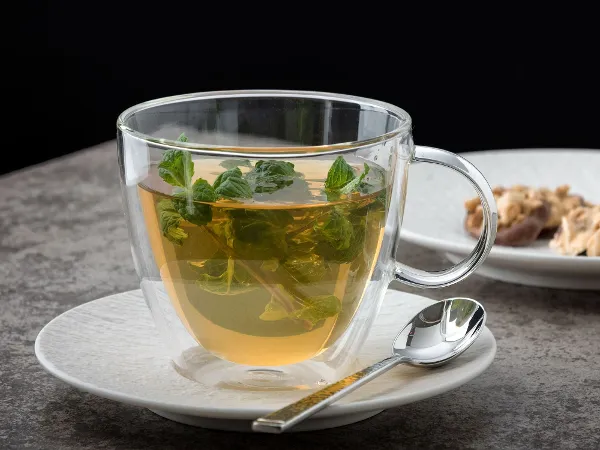
Matcha tea
Matcha tea is a bright, light green color and has a sweet, delicate, tart aroma. Matcha is an agreeable green tea that has been ground into a fine powder. Green tea powder has been highly valued in Asia for thousands of years for its health benefits.
Today, it is not only used for the preparation of fine Matcha tea, but many foods are also refined with Matcha. For example, drinks such as lemonade, cocktails, and dishes such as desserts or pasta sauces. But Matcha is much more than just a food trend!
How to prepare Matcha tea correctly
In order to enjoy the extraordinary aroma and beneficial effects of Matcha, the green tea powder must be prepared correctly. Unlike other types of green tea, Matcha is not made into an infusion. The tea plant is ground so finely that the powder dissolves in hot water and is drunk with the tea.
Preparation of Matcha tea and variations
In Japan, Matcha is central to tea culture, and is prepared in an elaborate, ritualistic ceremony. However, its preparation is also important to preserve the healthy ingredients in Matcha.
A Matcha bowl (Chawan) and a special bamboo whisk (Cha-sen) are required for preparation. Pour one to two grams of Matcha powder into the bowl and add 2 to 3 ounces of water. The water should be freshly boiled and no hotter than 176 degrees Fahrenheit. Low limescale water is ideal, but if the tap water is hard, use a water filter or, alternatively, still mineral water.
Stir the mixture of hot water and green tea powder in the Matcha bowl with a bamboo whisk until frothy. Make whisking movements loosely with the wrist, roughly in the shape of the letter ‘M.’ A deep and firm foam on the tea is a sign of successful Matcha tea.
Matcha tea can be prepared stronger or weaker depending on taste. In Japan, stronger Matcha is called Koicha and a more diluted Matcha is called Usucha.

How to make Matcha tea?
Matcha tea, like all green tea, is made from the Camellia Sinensis tea plant. However, cultivation and harvesting are very time-consuming: The tea bushes are covered with black nets or bamboo mats a few weeks before harvesting, to protect them from the sun.
In the shade, the plants develop a higher content of effective ingredients such as caffeine or theanine. Chlorophyll production is also stimulated - this is what gives Matcha tea its bright, light green color.
After the leaves have been picked, they are steamed and gently dried. Stems and leaf veins are carefully removed so that only the most tender parts of the leaf remain. These are ground into a fine powder in stone mills.
It is important to keep the green tea powder tightly sealed, cool and dry. After harvesting, it should be used as fresh as possible.

Health benefits of Matcha tea
The health benefits of green tea have been proven in extensive studies. For example, green tea helps to prevent diabetes as well as vascular and cardiovascular diseases. It reduces the risk of tooth decay and osteoporosis and strengthens the immune system
.The special combination of ingredients in green tea is responsible for these positive health effects. In addition to Caffeine, these include many minerals and trace elements such as Calcium, Iron, Potassium and Fluoride as well as important amino acids such as Theanine.
The so-called secondary plant substances, called catechins, play a special role. They act as antioxidants, neutralizing free radicals in the body and thus protecting the cells.
Matcha contains a high concentration of catechin epigallocatechin gallate, or EGCG for short. This substance helps to prevent various types of cancer. As part of a balanced diet, Matcha tea can be a valuable aid to weight loss. It stimulates the metabolism and promotes fat burning and digestion. Matcha is particularly healthy compared to other types of green tea.
Preparation and enjoyment of Matcha tea
Matcha has a high concentration of valuable ingredients due to its particularly gentle method of cultivation. The body can better utilize these ingredients in the finely ground powder. And, as the whole tea leaf is consumed rather than just the infusion, the body absorbs larger quantities of its healthy active ingredients.
The positive effect is at its best when Matcha is consumed in combination with other green tea varieties such as Sencha, Gyokuro and Bancha
.Each green tea has specific ingredients that are particularly effective when combined with each other.
Care should also be taken to use original Matcha powder. Flavored, diluted or mixed powders are nowhere near as healthy as pure green tea powder.
Matcha is so popular not only because of its healthy benefits, but also due to its exceptional taste, which is highly appreciated by tea drinkers. Matcha is mildly aromatic, less bitter than ordinary green tea and very creamy. It can be consumed regularly or just in an occasional cup.
For many, Matcha is a wonderful alternative to coffee. It doesn't always have to be an elaborate tea ceremony - simply create your own personal tea ritual - and take time to enjoy the experience of a soothing Matcha tea.







